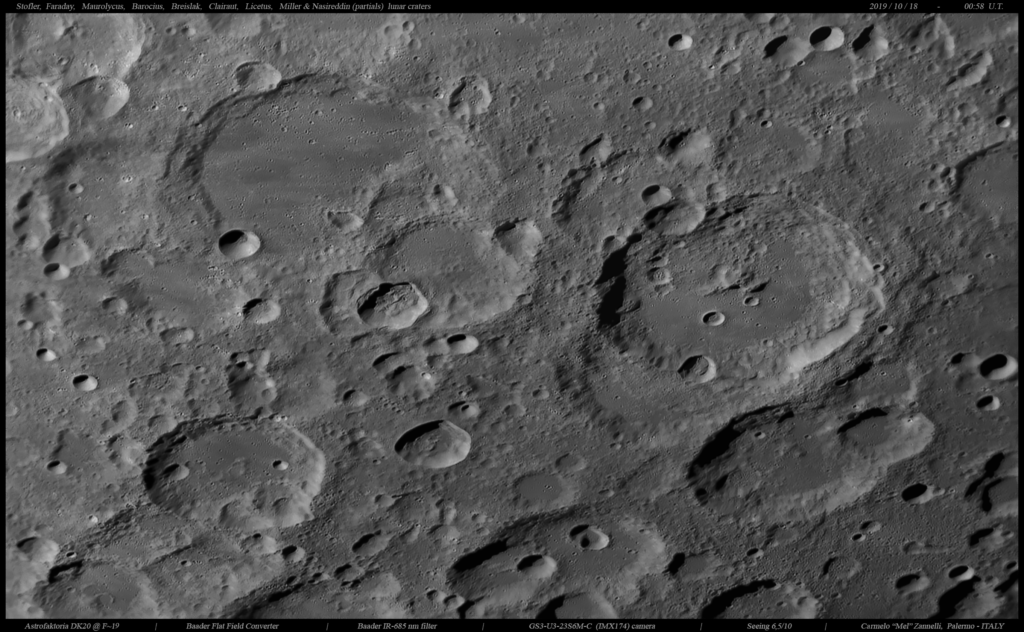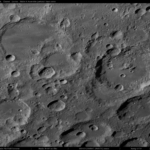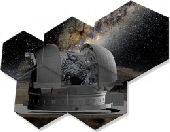Italiano:
Il cratere lunare “Stöfler” è un grande cratere da impatto lunare del diametro di 129,87 km, situato negli altopiani meridionali della Luna.
Si trova a ovest del cratere “Maurolycus” e i crateri “Miller” (qui visibile parzialmente al vertice in alto a sinistra) e “Nasireddin” (subito sotto il precedente, visibile per metà) si trovano a loro volta ad ovest di esso.
Il bordo di Stöfler è consumato ed eroso, ma il contorno rimane relativamente intatto, tranne nel settore sudorientale in cui è stato ricoperto dal cratere “Faraday”. Il cratere “Stöfler-K”, molto più piccolo, si intromette nel bordo nord-occidentale mentre “Stöfler-F” forma una rientranza nella base della parete interna sud-occidentale. Il fondo di Stöfler è stato riempito con depositi di lava, provenienti da flussi ed ejecta dagli impatti del bacino, ed è relativamente piatto e privo di caratteristiche nella sua parte nord-occidentale; se c’era un picco centrale, ora è stato sepolto. Il fondo ha un’albedo basso, il che rende il cratere relativamente facile da identificare in quanto è uno dei pochi crateri, in questa regione della superficie lunare, che ha un fondo scuro. Sul suo fondo sono anche visibili evidenti tracce di materiale a raggi luminosi proveniente dall’impatto del cratere Tycho, situato molto più ad ovest.
“Faraday” è un cratere situato sul bordo sud-orientale del più ampio cratere Stöfler, e l’orlo nord-occidentale di Faraday forma un enorme bastione roccioso attraverso il fondo piatto di Stöfler. Ad ovest di Faraday si trova il cratere “Maurolycus”. Il margine di Faraday è stato significativamente ricoperto da successivi impatti, in particolare da una coppia di crateri situata lungo il bordo sudovest, e da un cratere lungo il bordo nordovest. Nel cratere si trova un basso crinale che si estende da sudovest a nordest, dividendo il fondo del cratere quasi a metà.
Il cratere “Maurolycus” (nell’immagine, a destra di Stofler e faraday) è una formazione circolare di 117 Km che costituisce un’interessante coppia con il suo contiguo cratere “Barocius”. Ha versanti molto scoscesi, specialmente ad est, su cui si trovano Maurolycus-D, DA ed F a nord, Barocius a sud e presenta una doppia parete a sud-ovest. Il fondo è piatto con numerosi crateri tra cui Maurolycus-J al centro, e Maurolycus-M ad ovest.
Il cratere “Barocius” è una formazione circolare di 85 Km situata sulla parete sud-est del citato Maurolycus. I versanti sono abbastanza scoscesi e su di essi si sovrappongono Barocius-B e C a nordest. Le pareti sono alte, specialmente a sudest e sul fondo tormentato si trovano Barocius-W, una piccola montagna decentrata, piccoli crateri e linee di creste.
Questi i crateri più rilevanti, visibili nell’immagine:
Stofler, Faraday, Maurolycus, Barocius, Breislak, Clairaut, Licetus, Miller e Nasireddin (parziali).
Ad maiora… semper!
Dettagli tecnici:
Telescopio Astrofaktoria DK20 @ ~ F/19 – Baader FFC Multiplier – Baader IR 685nm filter – GS3-U323S6M-C camera – Seeing 6,5/10 in IR band – sito: Palermo @ my personal Observatory
English:
The lunar crater “Stöfler” is a large lunar impact crater with a diameter of 129.87 km, located in the southern highlands of the Moon. It is located west of “Maurolycus” and “Miller” crater (here partially visible at the top left corner) and “Nasireddin” crater (just below the previous one, half visible) are located west of it.
The edge of Stöfler is worn and eroded, but the outline remains relatively intact, except in the southeastern sector where it was covered by the “Faraday” crater. The much smaller “Stöfler K” crater intrudes into the northwestern edge while “Stöfler F” forms a recess in the base of the southwestern interior wall.
The floor of Stöfler has been filled with deposits, coming from lava flows and ejecta from the impacts of the original basin, and is relatively flat and without characteristics in its North-western part; if there was a central peak, it has now been buried. The floor also has a low albedo, which makes the crater relatively easy to identify as it is one of the few craters in this region of the lunar surface that has a dark bottom. On the bottom are also visible traces of light-beam material from the impact of Tycho crater, located to the west.
“Faraday” is a crater located on the southeastern edge of the larger Stöfler crater. The northwestern edge of Faraday forms a huge rocky rampart across the flat bottom of Stöfler. To the west of Faraday is the Maurolycus crater. Faraday’s margin was significantly covered by successive impacts, in particular by a pair of craters located along the southwestern edge, and by a crater along the northwestern edge. In the crater there is a low ridge that extends from southwest to ordest, dividing the bottom of the crater almost in half.
The “Maurolycus” crater (to the right of Stofler and faraday) is a circular formation of 117 Km which forms an interesting couple with its contiguous Barocius crater. It has very steep slopes, especially in the east, on which Maurolycus-D, DA and F are located in the north, Barocius in the south and has a double wall in the south-west. The floor is flat with numerous craters including Maurolycus-J in the center and Maurolycus-M in the west.
The “Barocius” crater is an 85 km circular formation located on the southeast wall of the aforementioned Maurolycus. The slopes are quite steep and Barocius-B and C overlap on the north-east. The walls are high, especially in the south-east and on the tormented floor are Barocius-W, a small decentralized mountain, small craters and ridge lines.
These are all the most relevant craters, visible in the image:
Stofler, Faraday, Maurolycus, Barocius, Breislak, Clairaut, Licetus, Miller and Nasireddin (partially visibles).
Ad maiora… semper!
Technical Details:
Astrofaktoria DK20 @ ~ F/19 telescope – Baader FFC Multiplier – Baader IR 685nm filter – GS3-U323S6M-C camera – Seeing 6,5/10 in IR band – site: Palermo @ my personal Observatory



One Comment
Davvero eccezionale!! Complimenti!!